Fostering in England 2018 to 2019: main findings
Updated 26 January 2021
Applies to England
The Fostering in England 1 April 2018 to 31 March 2019 release also includes:
- data tables
- methodology
- pre-release access list
About this release
This release covers:
- the numbers of foster carers and foster places and placements, in both local authority (LA) and independent fostering agencies (IFA)
- data relating to foster children, types of foster care, registrations, de-registrations, and a range of other subjects
- the period between 1 April 2018 and 31 March 2019
There has been an increase in the number of both approved fostering households and children in foster care.
On 31 March 2019, there were 44,450 fostering households, a 2% increase compared with 31 March 2018. In the same period, there has been a 3% increase in the number of children in foster care. There were almost 55,000 children and young people placed with foster carers on 31 March 2019.
There has been a decrease in the number of unoccupied places, available for children to be placed into.
Although the number of approved fostering places has increased by 1% since 31 March 2018, the number of children entering foster care has increased at a faster pace (3%). This means that there were fewer places available for children to be placed in on 31 March 2019 than the same date in 2018.
IFAs have a greater proportion of foster carers from non-White ethnic groups than in the LA sector.
On 31 March 2019, 21% of all carers in IFAs were from non-White ethnic groups, compared with 12% of carers in LAs. During 2018 to 2019, 24% of newly approved carers in IFAs were from non-White ethnic groups, compared with 10% of new carers in LAs.
The gap between young people Staying Put in LAs and IFAs continues to exist.
Despite the gap between the percentage of young people Staying Put in LAs and IFAs closing slightly this year, it remains substantial at 16 percentage points.
The proportion of unplanned endings to placements that resulted in the child moving within 24 hours has increased.
During 2018 to 2019, around 5,800 children and young people experienced unplanned endings. Of these children and young people, 31% were moved within 24 hours. This is an increase of 6 percentage points compared with the previous year, and 10 percentage points from 2016 to 2017.
Of all missing children, almost 1 in 5 were missing for over 1 week in total.
In 2018 to 2019, of the 6,395 children who went missing, 19% (1,190) were missing for over 1 week in total.
Introduction
This statistical release covers local authority (LA) fostering agencies and independent fostering agencies (IFA) in England in the year 1 April 2018 to 31 March 2019. It includes data about fostered children, foster carers, recruitment, and capacity of providers. In the latest DfE published data covering 2017 to 2018, fostered children represented nearly three quarters of all children in care, or fewer than 1% of all children in England.
This release uses data returned to Ofsted by the agencies, and so may reflect changes that have happened both in the sector and in how agencies are recording and reporting data. The data helps inform fostering policy and serves as a point of reference for all fostering agencies in the country.
Throughout this release, we have included historical trend data for up to 4 years prior to 2018 to 2019, where available.
Fostering households
The number of households and number of carers increased this year, breaking the trend of slow decline. More than half of all approved households were approved to offer multiple types of foster care, meaning they could provide different types of placement dependent on the needs of the child. Permanent or not permanent care were most likely to be listed as a household’s primary placement offer. IFA households were more likely to be approved for multiple types of care than LA households.
The proportional split of households approved to care for 1, 2, 3 and 4 or more children has remained similar over the last year, possibly indicating that the shift towards larger households seen previously is slowing down.
The number of approved foster places continued to increase. Although the number of places did increase, the number of places that were either filled by children or ‘not available’ also increased and at a faster pace. This meant that there were fewer places available for children who needed foster care than in previous years.
Numbers of households, by type
The number of fostering households in England has risen this year. It is at the highest level since 31 March 2015, following declines in 2016, 2017 and 2018. At 31 March 2019, there were 44,450 approved fostering households, an increase of 2% from last year (43,475).
Looking at the main type of placement offered by a household (primary placement offer), 3 types accounted for 91% of all fostering households: not permanent (41%), permanent (35%) and family and friends (16%). There was an increase in the number of households whose primary offer was permanent or family and friends compared with last year. Households with not permanent offers decreased in the same period.
Figure 1: Change in number of households by primary placement offer, 2016 to 2019
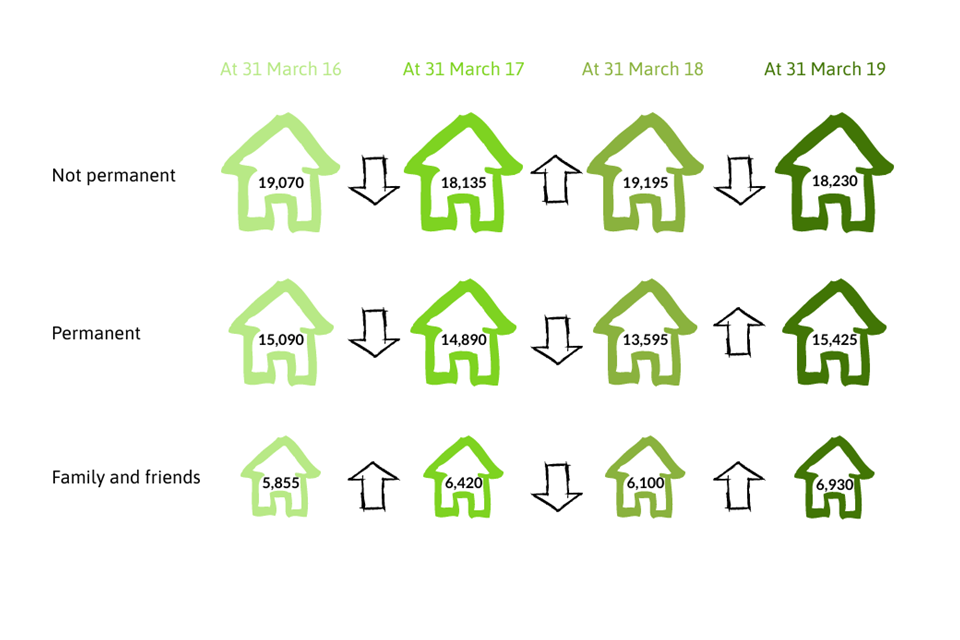
Other types of primary placement offers include: short breaks, emergency, parent and child, multi-dimensional treatment, fostering to adopt, remand, or other types of placement as well as shared-care short breaks.
The number of households with emergency fostering as their primary offer has decreased by over a third in the last year (from 385 to 245). However, when looking at all households that are approved for emergency care, not just those with emergency care as their primary offer, the decrease between 31 March 2018 and 31 March 2019 is much less substantial (see Table 1).
Households that offered a range of foster care
In line with last year, just over half of all households (53%) offer multiple types of foster care. Of the 44,450 approved fostering households in England, 30% were approved for 2 types of care, 12% for 3 types of care and 11% for 4 or more types of care.
On 31 March 2019, more households offered permanent care within their approval, compared with 31 March 2018. Households offering family and friends care also saw an increase. In the same period, the number of households that offered short breaks decreased, as did the number of those offering fostering to adopt. (see Table 1).
On 31 March 2019, short breaks, and emergency, foster care placements were much more likely to be additional offers, rather than primary placement offers. This is similar to last year. Only 1% of fostering households offer emergency care as their primary offer. This increases to 18% when considering all households that are approved for emergency care as either a primary or additional offer. Only 3% of households have short breaks as their primary offer, increasing to 23% when considering all households that are approved for short breaks.
Table 1: Number of households, by offer type within their approval 31 March 2019
| Type of fostering | Number at 31 March 2018 | Number at 31 March 2019 | Percentage at 31 March 2018 | Percentage at 31 March 2019 |
|---|---|---|---|---|
| Not permanent | 30,305 | 30,660 | 70 | 69 |
| Permanent | 20,890 | 22,105 | 48 | 50 |
| Short breaks | 11,145 | 10,310 | 26 | 23 |
| Emergency | 8,635 | 8,185 | 20 | 18 |
| Family and friends | 6,220 | 7,180 | 14 | 16 |
| Parent and child | 2,335 | 2,440 | 5 | 5 |
| Other | 2,185 | 1,505 | 5 | 3 |
| Shared-care short breaks | 1,260 | 1,235 | 3 | 3 |
| Multi-dimensional treatment | 780 | 800 | 2 | 2 |
| Fostering to adopt | 625 | 575 | 1 | 1 |
| Remand | 310 | 205 | 1 | 0 |
| Not known | 295 | 545 | 1 | 1 |
Among IFAs, the proportion of households approved for multiple types of care was again much higher than among LAs: 89% compared with 35%.
Almost two thirds of LA households were approved for one type of care (19,115 households, 65%) compared with just one tenth of IFA households (1,640 households, 11%). Over half of IFA households were approved for 3 or more types of care (8,035 households, 53%) compared with 1 in 14 LA households (2,150, 7%).
As stated in previous publications, because family and friends households are households that occur only in the LA sector, they partly contribute to the difference between the sectors. This is due to family and friends households being much less likely to be approved to offer other types of foster care.
Table 2: Number of households by sector and by offer type within their approval, as at 31 March 2019
| Type of fostering | Number of LAs | Number of IFAs | Percentage of households in LAs | Percentage of households in IFAs |
|---|---|---|---|---|
| Not permanent | 16,715 | 13,945 | 57 | 92 |
| Permanent | 9,925 | 12,175 | 34 | 81 |
| Short breaks | 4,470 | 5,840 | 15 | 39 |
| Emergency | 1,525 | 6,655 | 5 | 44 |
| Family and friends | 7,180 | 0 | 24 | 0 |
| Parent and child | 325 | 2,115 | 1 | 14 |
| Other | 230 | 1,275 | 1 | 8 |
| Shared-care short breaks | 1,120 | 115 | 4 | 1 |
| Multi-dimensional treatment | 155 | 650 | 1 | 4 |
| Fostering to adopt | 315 | 260 | 1 | 2 |
| Remand | 20 | 185 | 0 | 1 |
| Not known | 360 | 185 | 1 | 1 |
Fostering household sizes
Figure 2: Fostering household sizes, as at 31 March 2019 by sector
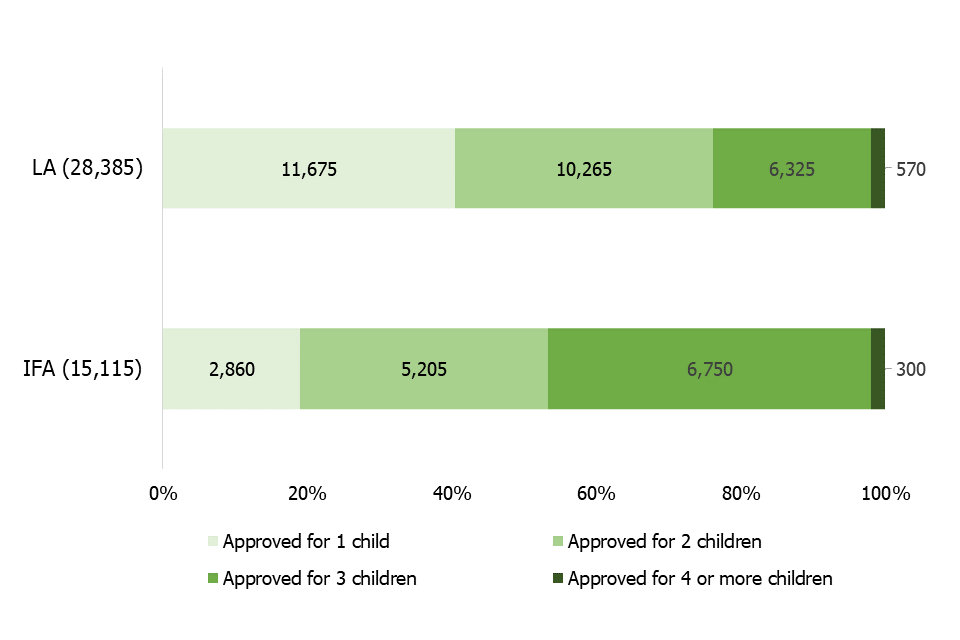
The highest proportion of all households (35%) were approved for 2 children (15,470), broadly in line with last year (36%). Compared with 5 years ago, the proportional split in households by size has remained similar, with the biggest change seen in households approved for 2 children. On 31 March 2019, 35% of households were approved for 2 children, which is 4 percentage points lower than 31 March 2015.
On 31 March 2019, IFAs were more likely to have larger households than LAs: 47% of IFA households were approved for 3 children or more compared with 24% of LA households. Since 31 March 2015, there has been an increase in the proportion of larger households (3 children or more), from 36% in IFAs and from 23% in LAs.
On 31 March 2019, households that were newly approved IFA households during 2018 to 2019 were of a similar size as last year, with 30% approved for one child, 34% approved for 2, and 36% approved for 3 children or more.
There were 265 households that recorded ‘0’ for the number of children they were approved to care for, these have been excluded when calculating these percentages. All 265 households had a primary placement offer of family and friends or fostering to adopt.
In the LA sector, newly approved households remain much more likely to be approved to look after smaller numbers of children. Sixty-one per cent of households approved in this year were for one child, compared with 30% among IFAs.
Fostering capacity
Changes in numbers of approved places
In total, across all fostering placement types, there were 88,370 approved fostering places in England on 31 March 2019. This represented a 1% increase from the same point in the previous year (87,120) and a 10% increase since 31 March 2015 (80,660).
Figure 3: Approved fostering places on 31 March by sector, 2015 to 2019
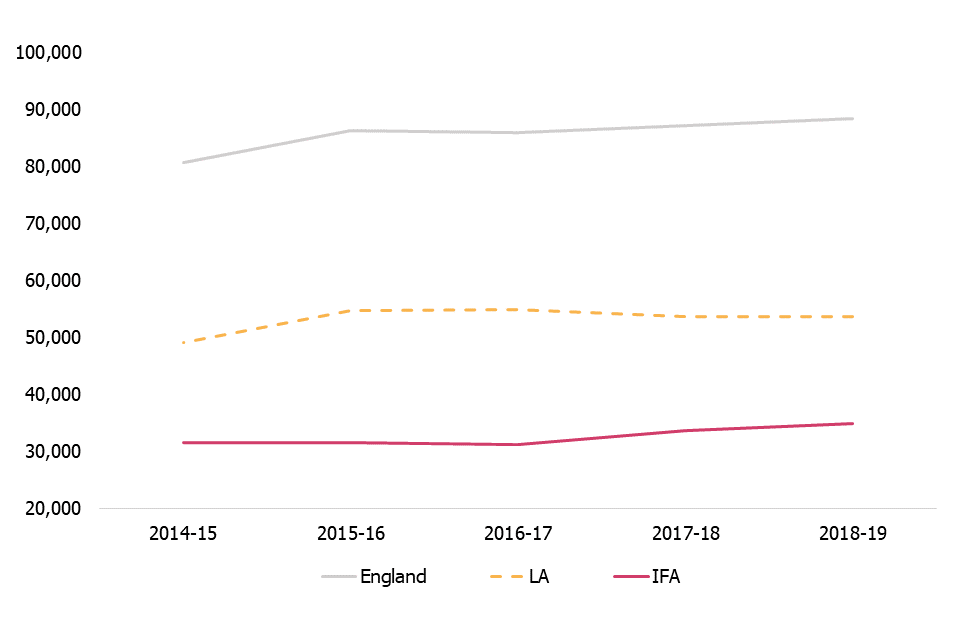
The increase in approved places in recent years can be attributed mainly to the IFA sector; approved places in LAs have declined slightly since 31 March 2016. On 31 March 2019, more places were approved by LAs (61%), in line with previous years (see Figure 3).
Occupancy
On 31 March 2019, 63% of fostering places were filled (54,870) and 19% were vacant (16,080). The remaining 18% were ‘not available’ (15,645). There were 1,440 households that reported places used for short breaks. Due to some households having an exemption in place during 2018 to 2019, the total number of approved places will not match the sum of places by type.
The number of filled places has increased since 31 March 2018 (from 53,205). The DfE reported 55,200 children in care in foster placements at 31 March 2018.
Figure 4: Proportion of fostering places, by occupancy status on 31 March
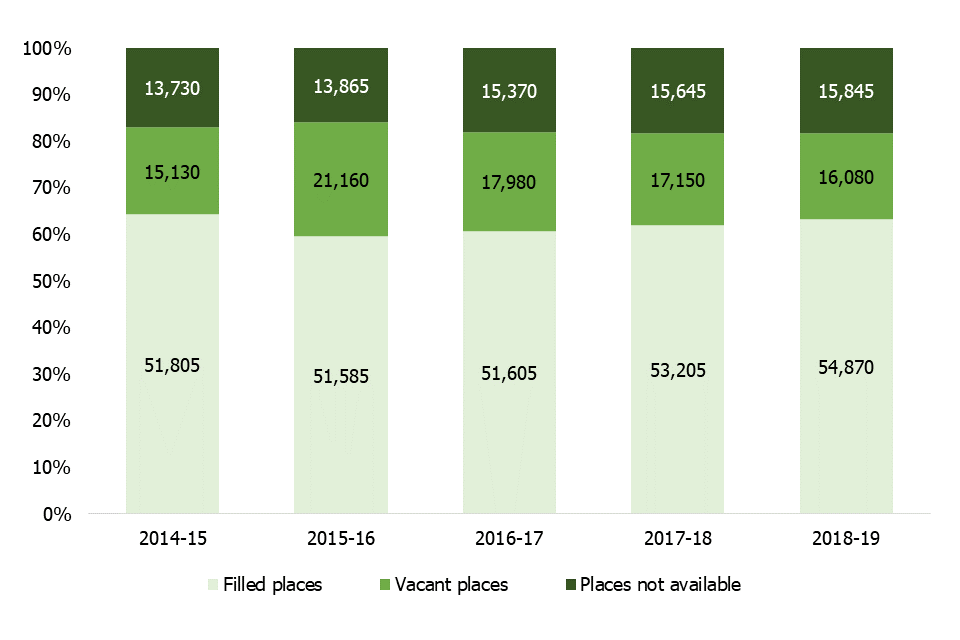
On 31 March 2019, the proportion of places that were filled was slightly lower than those reported on 31 March 2015 (64%), though some fluctuation occurred in the period between. During the same period, the proportion of vacant places has remained the same (19%) and places reported as ‘not available’ have increased slightly (from 17% to 18%).
Unavailable fostering places
On 31 March 2019, there were 15,845 places reported as ‘not available’, almost 1 in 5 (18%). The actual number of places that were ‘not available’ has been increasing since 31 March 2015, though it has remained stable over the last 3 years when considered as a proportion of all places.
There were 7,800 ‘not available’ places among LAs and 8,045 among IFAs. Of all approved places, IFAs had a higher proportion of ‘not available’ places compared with LAs (24% compared with 15%). This is a trend that has continued since 2015. This may include a number of households that are approved for more children that they are able to care for. Therefore, the analysis must be used with caution.
Table 3: Number and percentage of ‘not available’ places by reason, 2018 and 2019
| Reason for not available place | Number at 31 March 2018 | Number at 31 March 2019 | Percentage at 31 March 2018 | Percentage at 31 March 2019 |
|---|---|---|---|---|
| Carer reasons (other) | 3,240 | 3,935 | 21 | 25 |
| Carer(s) taking a break/pending resignation | 3,100 | 2,640 | 20 | 17 |
| Needs of child currently in placement | 2,860 | 2,650 | 18 | 17 |
| Only available if sibling group placed | 2,245 | 2,530 | 14 | 16 |
| Used as a staying put place | 1,320 | 1,335 | 8 | 8 |
| Reason unknown/other | 1,105 | 1,030 | 7 | 7 |
| Carer(s) under investigation | 675 | 730 | 4 | 5 |
| Reserved for pending placement | 535 | 480 | 3 | 3 |
| Reserved for shared-care placement | 530 | 515 | 3 | 3 |
On 31 March 2019, there was an increase in the number of places ‘not available’ due to ‘other’ carer reasons compared with last year – a percentage increase of 21%. Other carer reasons reported included carer health, carers being away on holiday and family circumstances (such as bereavement, overnight guests or change in property).
The number of places reported as ‘not available’ due to carer(s) taking a break or pending resignation decreased by 15% (from 3,100 to 2,640) from 31 March 2018 to March 2019.
Recruitment and retention
Recruitment in year
During 2018 to 2019, there were 127,850 initial enquiries to be a foster, which is an increase of 9% on the previous year (117,335). Much of this increase is due to the IFA sector, where there were over 9,000 (11%) more enquiries during 2018 to 2019 compared with the previous year. The LA sector’s increase was 4%.
In total, 9,740 applications to be a foster carer were received during 2018 to 2019. This is a decrease compared with last year (10,540 applications). Of all applications received during 2018 to 2019, 6,235 (64%) were completed in year. This is a slight decrease compared with 2017 to 2018, when 66% of applications were completed in year.
A higher proportion of applications received by IFAs in 2018 to 2019 were completed by 31 March 2019 compared with those received by LAs (68% and 59% respectively). The gap between the number of LA and IFA applications completed in year has decreased compared with last year (72% and 58% respectively).
Figure 5: Applications received in 2018 to 2019, by status on 31 March 2019
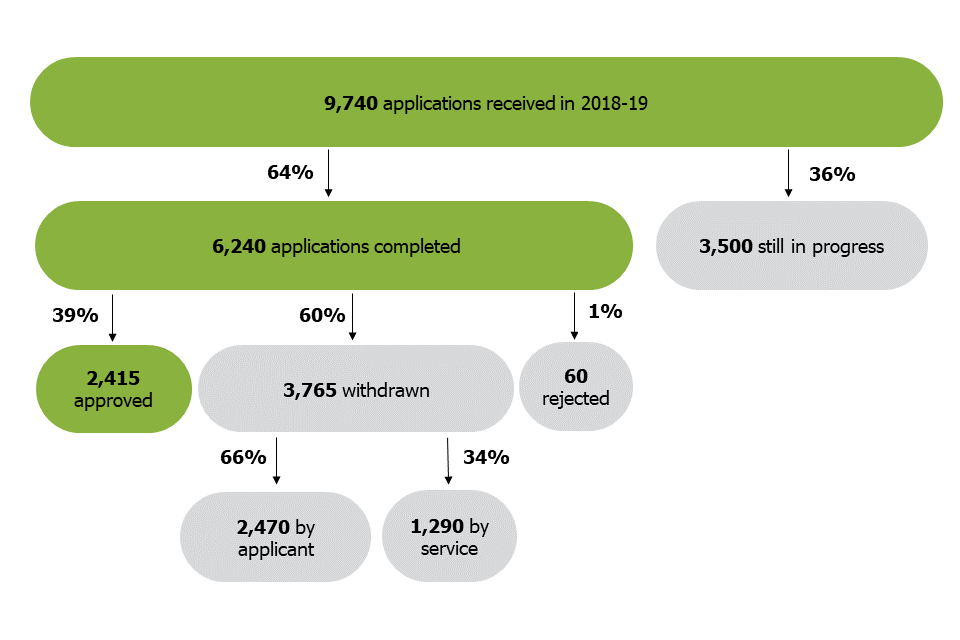
In total, there were 10,485 fostering households successfully approved during 2018 to 2019, of which 8,400 were still approved on 31 March 2019. The vast majority of households (89%) that were both approved and deregistered during 2018 to 2019 were family and friends or foster to adopt households in the LA sector.
The table below shows the primary offer type of the newly approved households, by sector.
Table 4: Types of foster care offered by newly approved households in 2018 to 2019, by sector
| Primary offer | Number of LAs | Number of IFAs | Percentage of LAs | Percentage of IFAs |
|---|---|---|---|---|
| Not permanent | 1,440 | 1,210 | 25 | 45 |
| Permanent | 490 | 1,215 | 9 | 45 |
| Short breaks | 155 | 60 | 3 | 2 |
| Emergency | 10 | 45 | 0 | 2 |
| Family and friends | 3,290 | 0 | 58 | 0 |
| Parent and child | 5 | 20 | 0 | 1 |
| Other | 15 | 45 | 0 | 2 |
| Shared-care short breaks | 50 | 5 | 1 | 0 |
| Multi-dimensional treatment | 10 | 85 | 0 | 3 |
| Fostering to adopt | 210 | 30 | 4 | 1 |
| Remand | 5 | 0 | 0 | 0 |
| Not known | 0 | 0 | 0 | 0 |
Foster carers
Approved foster carers
The number of approved foster carers has increased by 2%, from 73,530 on 31 March 2018 to 75,260 on 31 March 2019. The number of carers increased by 2% in both the LA and IFA sectors, with LA agencies accounting for almost two thirds of all carers (65%), as in previous years.
Ethnicity
On 31 March 2019, most foster carers were White (83%). This figure includes 2,215 foster carers who are White ethnic minorities representing 4% of White carers and 3% of all carers. This is less than the proportion of White people in the adult (aged 25 and older) population (88%).
Following the long-term trend, there was a greater proportion of foster carers from non-White ethnic groups in IFAs than in the LA sector. In IFAs, 21% were from non-White ethnic groups, compared with 12% in LAs. Of all foster carers approved at 31 March 2019, 2% had an ethnicity of ‘unknown’ recorded. As such, the percentages relating to ethnic groups do not always add up to 100%.
We also collected the ethnicity of fostered children and, as described later in this report, 23% of fostered children were from non-White ethnic groups on 31 March 2019.
Figure 6: Ethnicity of foster carers by sector, as at 31 March 2019 and approved during 2018 to 2019
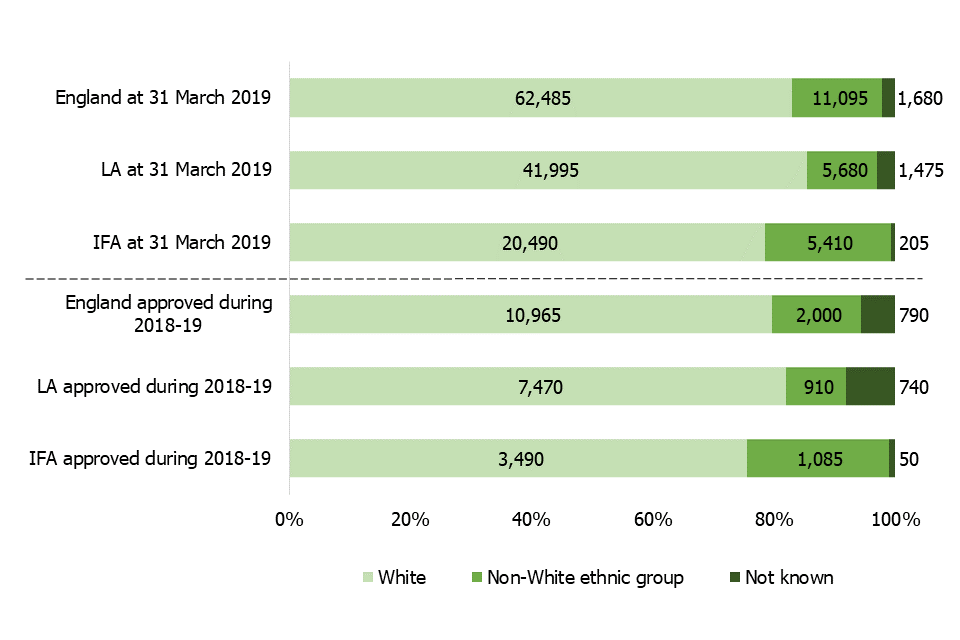
Of all foster carers approved during 2018 to 2019, 80% were White and 15% were from non-White ethnic groups. The remaining 6% were reported with their ethnicity marked as ‘unknown’; the majority of these were with LA agencies.
In the LA sector, 82% of newly approved carers were White, compared with 75% in IFAs. Conversely, 10% were from non-White ethnic groups, compared with 24% in IFAs.
Children and young people
This year has seen another increase in the number of children and young people placed with foster carers. The trend of the majority being placed with LAs is continuing.
The proportion of fostered children from non-White ethnic backgrounds remains the same as on 31 March 2018 but has seen an increase of 1 percentage point since 2015. Of all children fostered, IFAs continue to report a higher proportion of disabled children compared with LA agencies.
Almost a third of children who were subject to an unplanned ending were moved within 24 hours of the decision to end the placement, an increase on the previous year.
The Staying Put initiative was introduced to give stability and support to young people when they turn 18. Young people placed with LA agencies were more likely to stay with their carers after they turned 18 (58%), compared with those placed with IFAs (42%). Despite the gap between the percentage of children Staying Put in LAs and IFAs closing slightly this year, it remains substantial at 16 percentage points.
Children and young people who go missing from foster care should always be offered a return home interview (RHI) on their return. A RHI is designed to give the child and the placing LA a chance to discuss why the child went missing and agree actions to try to prevent further instances of going missing. During 2018 to 2019, almost 40% of missing children and young people did not receive a RHI.
This year saw the highest number of allegations of abuse made against foster carers in any year since 2014 to 2015; 2,705 allegations. Physical abuse continues to account for the largest number of allegations.
Number of children fostered
In total, agencies reported 54,870 children and young people in placement on 31 March 2019, a 3% increase from last year. This is the highest number of children reported over the last 5 years and sees an increase of 6% since March 2015. Latest figures published by the Department for Education (DfE) reported slightly higher numbers of children in foster care (55,200), which could be explained by slight differences in collection methodology.
The majority of children were in LA fostering places (65% or 35,820), and the remainder (35% or 19,050) were placed through IFAs. This continues the trend seen since 31 March 2015.
Figure 7: Total number of fostered children in England with percentage of sector split, from 31 March 2015 to 31 March 2019
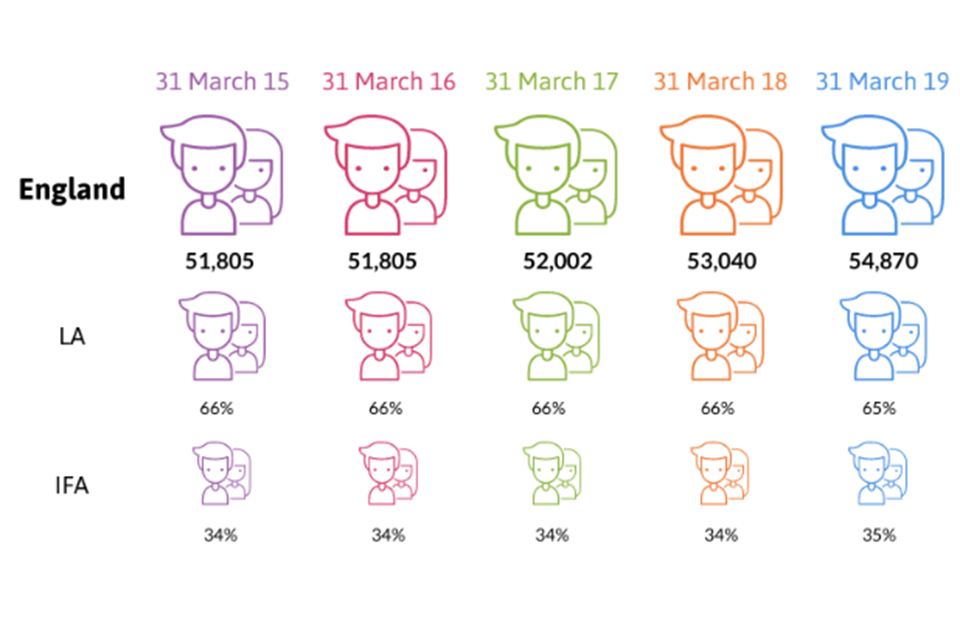
Characteristics of children
Ethnicity
White children accounted for 76% of all fostered children still placed on 31 March 2019. This is in line with the previous 2 years. Of all children, 23% of children belonged to non-White ethnic groups, the same as last year but an increase of 1 percentage point since March 2015. The remaining 1% of children had their ethnic group recorded as ‘Unknown’, they are not represented in the figure below. This has been similar since 2014 to 2015.
Figure 8: Percentage of children and young people in foster care in England, by ethnicity and sector

Disability
Of all children in a placement on 31 March 2019, 9% were reported to be disabled, in line with the previous 3 years. IFAs reported a slightly higher proportion of disabled children (11% or 2,010) compared with LAs (9% or 3,170). Again, this was in line with what we have seen in the previous 3 years.
Children’s experiences
Placement stability
During 2018 to 2019, the number and proportion of fostered children who experienced an unplanned ending decreased slightly from previous years. From 7,485 (9%) in 2016 to 2017, when we first started collecting this data, to 5,815 (7%) in 2018 to 2019. Children placed with LA foster carers were slightly less likely to experience an unplanned ending (6% of children), compared with children placed with IFA carers (8%).
Despite the reduction in unplanned endings, the number and proportion of children who experienced at least 1 move within 24 hours of the decision to end the placement early increased. This increase was from 1,595 children in 2016 to 2017 (21%), to 1,775 in 2018 to 2019 (31%), which was a 10 percentage point increase. There were 115 children who experienced more than 1 unplanned ending within 24 hours during the year.
Of all the children who experienced unplanned endings, a third (1,910) stayed with the same agency, in line with the previous year. The majority of these children (77% or 1,480 children) were placed with LA fostering agencies at the time of the unplanned ending.
Staying Put
Of the 3,770 young people who turned 18 during 2018 to 2019, half continued to live with their foster carers. Although it is not known how long these young people remained with their foster carers, DfE data suggests that only around 30% of young people were still living with their foster carers at the age of 19.
Despite the slight increase seen over the past 2 years of young people Staying Put, from a low of 46% in 2016 to 2017, it has not yet returned to the levels seen in years prior, when percentages ranged from 52% to 54%. Figures published by the DfE present slightly higher proportions of young people Staying Put (55%). This is likely due to DfE including Staying Put data for some care leavers beyond the age of 18.
The proportion of young people Staying Put with IFA carers increased by 2 percentage points from the previous year, from 40% to 42%. The proportion who stayed living with LA carers remained the same at 58%, the highest proportion seen in recent years. Despite the gap between young people Staying Put in LAs and IFAs closing slightly this year, it remains substantial, at 16 percentage points.
Figure 9: Percentage of care leavers who remained with former foster carers after turning 18, by sector, 2014 to 2019
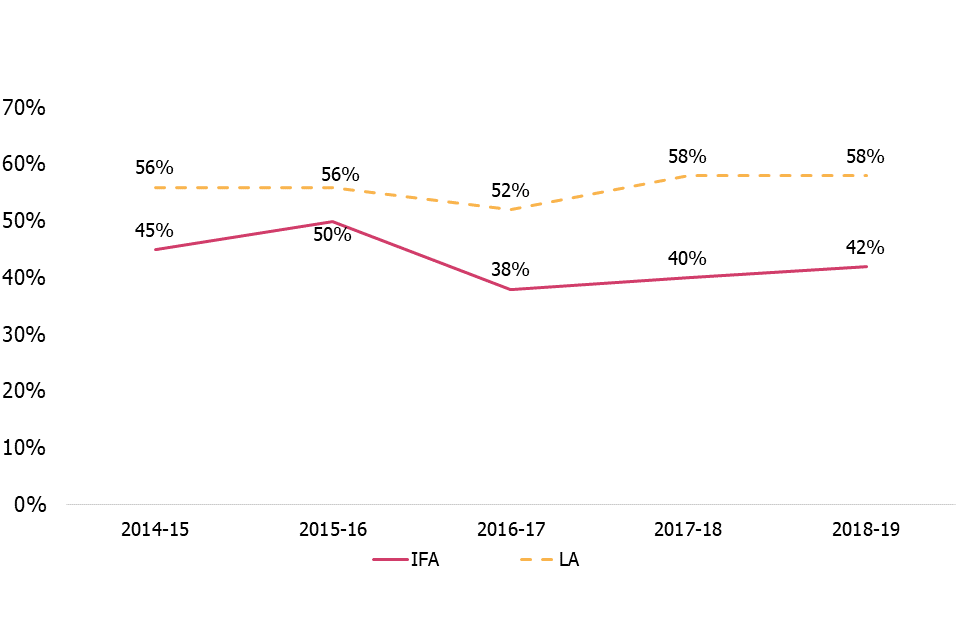
Safeguarding
Children going missing
During 2018 to 2019, a total of 6,395 children (8% of all fostered children) went missing, a total of 27,085 times. Although the number of children going missing, and missing incidents, has fallen slightly, it remains proportionally in line with the previous 2 years due to the increase in the number of fostered children. The average number of missing incidents per missing child remains at around 4.
In 2018 to 2019, the category of going missing primarily in order to have contact with family and friends continues to account for half of all missing children (3,285 or 51%). The proportion of children going missing for unknown reasons has, again, slightly increased from the previous year, from 18% to 21%. Since 2016 to 2017, this has increased by 5 percentage points. LAs account for the large majority of these unknown reasons at 82%, which is an increase from the previous year at 73%.
Table 5: Primary reasons for children going missing
Number (and percentage) of children missing from 2016 -2019
| Primary reason for going missing | 2016 to 2017 | 2017 to 2018 | 2018 to 2019 |
|---|---|---|---|
| Contact with family or friends | 3,615 (52%) | 3, 595 (53%) | 3,285 (51%) |
| Reason unknown | 1,140 (16%) | 1,200 (18%) | 1,325 (21%) |
| Any other known reason | 1,365 (20%) | 1,365 (20%) | 1,210 (19%) |
| Suspected sexual exploitation | 340 (5%) | 265 (4%) | 220 (3%) |
| Involvement in offending behaviour | 145 (2%) | 120 (2%) | 115 (2%) |
| Substance misuse | 125 (2%) | 140 (2%) | 110 (2%) |
| Because they are an asylum seeker | 135 (2%) | 100 (1%) | 75 (1%) |
| Bullying | 40 (1%) | 35 (1%) | 40 (1%) |
| Alleged abuse within the foster home | 15 (0%) | 20 (0%) | 20 (0%) |
The majority of those missing (81% or 5,205) were missing for less than one week. This is a slight increase from the previous 2 years (79%).
Of those children who went missing, 19% were missing for over a week in total. This is a slight decrease from the previous year (21%).
Figure 10: Percentage split of the duration of missing periods in 2018 to 2019
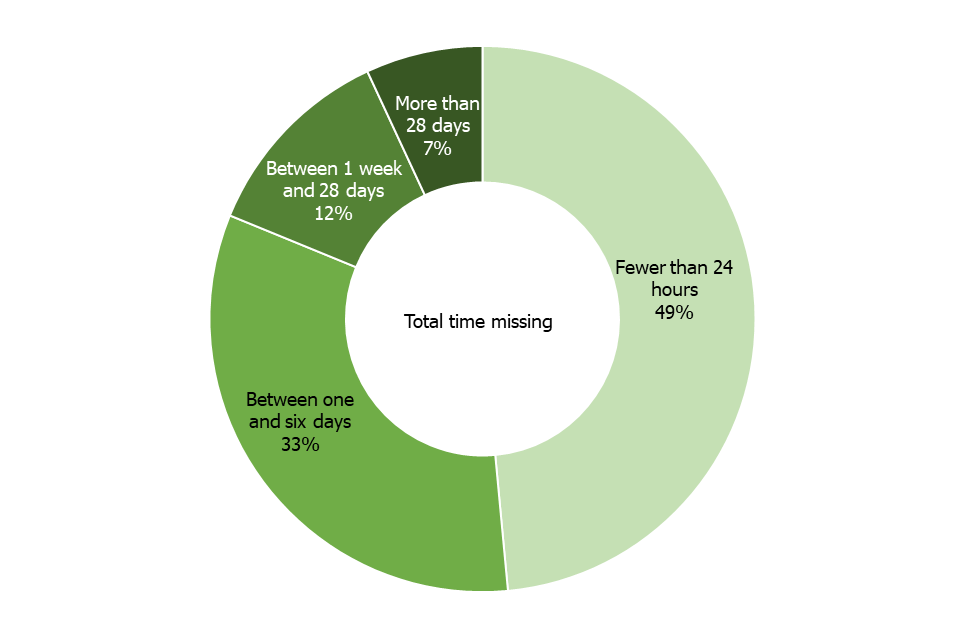
Of the 6,395 children who went missing, 3,935 (62%) received a return home interview (RHI). Although this is an increase of 5 percentage points since last year, there are still almost 40% of children not receiving a RHI.
Of the 2,460 children who went missing at least once and had no RHI (38% of all missing children), the slight majority were placed with IFAs (56% or 1,385). This is in line with the previous 2 years.
Child sexual exploitation
During 2018 to 2019, there were 2,765 (3%) children and young people placed in foster care who were considered to be at risk of child sexual exploitation. This is a decrease of 1 percentage point from 2017 to 2018.
Of the children at risk of child sexual exploitation, 63% were placed with LAs and 37% were placed with IFAs. This is proportionate to the breakdown of children in each sector and broadly in line with previous years.
Restraint
During 2018 to 2019, there were 1,135 incidents of physical restraint, which is a 6% decrease compared with the previous year (1,205). However, the number of children affected has increased slightly, by 2%, from 630 in 2017 to 2018, to 645 in 2018 to 2019. Since 2014 to 2015, the number of incidents of physical restraint, and the number of children affected, have gone up and down. However, the average number of incidents per child who experienced restraint has remained at around 2.
Although over the last 2 years there has been a continued decrease in the number of incidents of physical restraint, since 2014 to 2015, there has been an 11% increase in numbers, from 1,025 to 1,135.
During 2018 to 2019, the majority of incidents of physical restraint were reported within the IFA sector (78% of all instances). The large difference between sectors may reflect the level and nature of needs that children placed with IFAs have and could also be affected by variations in reporting processes between IFAs and LAs.
Allegations of abuse
During 2018 to 2019, there were 2,705 allegations of abuse made against foster carers. This is the highest number of allegations in any year since 2014 to 2015.
Figure 11: Total numbers of allegations of abuse made against foster carers from 2014 to 2015, to 2018 to 2019
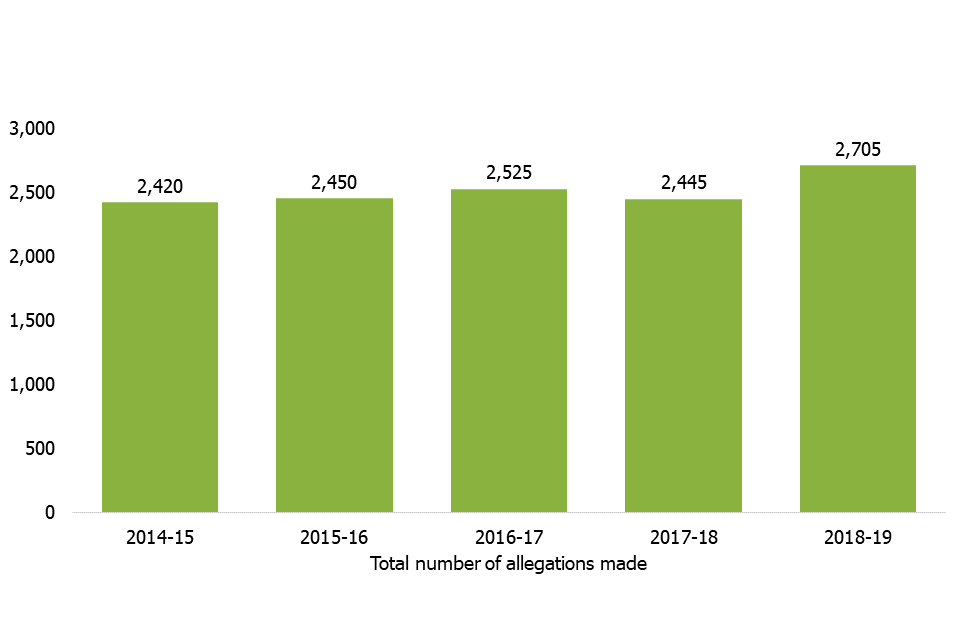
Just under two thirds of allegations of abuse in 2018 to 2019 (1,745 or 65%) were made by fostered children against their foster carers, which is the same proportion as last year. The other third came from other sources.
In the same way as last year, the majority of allegations (59%) were made in the LA sector, which is to be expected because more children are placed with LAs.
Physical abuse has continued to account for the largest number of allegations over the last 5 years. In 2018 to 2019, 58% of all allegations were related to physical abuse; this percentage has remained very similar since 2014 to 2015.
Allegations of sexual abuse continue to be the least common, accounting for 6%. This is a slight decrease from 8% in previous years.
Just over half (57%) of all allegations resulted in an outcome of no further action, and around a quarter (26%) were referred on, in line with previous years. Continued monitoring of foster carers was a more common outcome for LAs (19%) than for IFAs (14%).
Figure 12: Outcomes of investigations into allegations of abuse in 2018 to 2019 split by sector

On average, allegations were concluded more quickly in IFAs than in LAs. Of all allegations in IFAs, 55% were resolved in less than 21 days, compared with 48% in LAs.
Reasons for children and young people leaving their foster home
In 2018 to 2019, 29,525 children and young people left foster agencies, 35% of all children placed in the year. This has dropped from 36% last year, and a high of 37% in 2016 to 2017.
The largest proportion of children and young people who left a foster agency’s care left due to leaving care (11,660 or 39%). This has continued to be the main reason for young people leaving fostering agencies, and the percentage has been broadly the same over the last 3 years. Children leaving for this reason might have returned to live with their parents or other family member, become subject to a Special Guardianship Order, or been adopted.
During 2018 to 2019, 6% of children (1,880) left their fostering agency because they turned 18 but remained living with their foster carers under Staying Put arrangements. This is in line with previous years. The number of children who turned 18 and no longer lived with foster carers remained at 6% as with the previous 2 years.
There were 3% of children recorded as having an unknown reason for leaving care. This is half of that recorded for the previous 2 years.
Figure 13: Percentage of children and young people who left foster care during 2018 to 2019, by reason
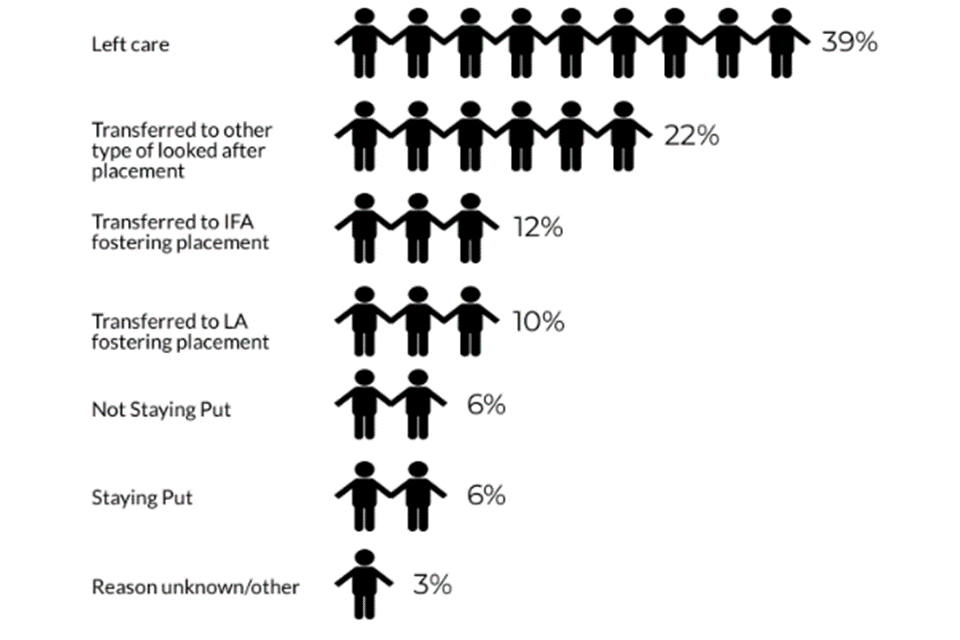
Revisions to previous release
This is the first release of this data for the period 1 April 2018 to 31 March 2019. This data is fixed point-in-time data and will not be revised.
The Fostering in England 1 April 2018 to 31 March 2019 page also includes:
- data tables
- methodology
- pre-release access list
Acknowledgements
Thanks to the following for their contribution to this statistical release: Klara Davies, Jade Davies and Kathryn Kaal.
If you have any comments or feedback on this publication, please contact Adam King on 03000 130020 or socialcaredata@ofsted.gov.uk
Glossary
A full definition of the terms below is available within the dataset Excel file.
Applications
Applications to be a foster carer are included if the applicant has started Stage 1, as outlined in the statutory guidance.
Approved foster carers
These are individual foster carers who were currently approved by a fostering service on 31 March 2019.
At risk (of child sexual exploitation)
This is used to describe a child for whom there is a concern that they will become subject to child sexual exploitation at some point. The risk does not need to have been confirmed by other professionals.
Child sexual exploitation
A form of child sexual abuse occurring when an individual or group takes advantage of an imbalance in power to coerce a child into sexual activity in exchange for something the victim needs or wants, or to increase the status or financial advantage of the perpetrator.
Continued monitoring of investigations into allegations of abuse
Under continued monitoring, the accused foster carer is monitored by the agency for a specified time. During this time, they may receive additional training, such as de-escalation or behaviour management. Once the specified time has elapsed, the outcome is reviewed and either referred to panel (if concerns remain) or resolved.
Disabled
Section 6 of the Equality Act 2010 defines a disabled person as someone who has a physical or mental impairment that has a substantial and long-term adverse effect on their ability to carry out normal day to day activities.
Exemption
An exemption is required in the specific situation in which a foster carer is asked to look after more than 3 children who are not all part of a sibling group, under sections 63(12) and Schedule 7(2) of the Children Act 1989.
Family and friends foster care
Foster care provided for children in care by a relative or friend who is approved by a fostering service to foster that particular child or children.
Fostering agencies
Fostering agencies recruit, prepare, assess, train and support foster carers. They can be run by the local authority, or independent (private companies or charities).
Foster places
This refers to the total number of places that foster carers are approved to provide, whether occupied or not. It relates to the capacity of foster care in England.
Foster placements
Foster placements refers to arrangements made for children to be looked after, in this context living with foster carers.
Initial enquiries
Initial enquiries about being a foster carer might include: booking onto or attending an information session, requesting information through email, post or phone, requesting or receiving a home visit, requesting an application form that they have not yet submitted, requesting information about a type of foster care not provided by your service.
Missing
In this context, ‘missing’ refers to children up to the age of 18 who have run away from their foster placement, have been abducted, or whose whereabouts are unknown; it does not include unauthorised absence when a child’s whereabouts are (thought to be) known.
Multi-dimensional treatment foster care (MTFC)
Multi-dimensional treatment foster care (MTFC) under the DfE scheme MTFC is a highly structured behavioural programme, providing wraparound multi-professional support and including daily communication between carers, the team and the school, aimed at diverting young people from peers who encourage anti-social behaviour.
No longer looked after
This refers to children who have ceased to be looked after (in care). They might have returned to live with their parents or other family member, or become subject to a Special Guardianship Order, or been adopted.
‘Not available’ places
These are foster care places in which no children are currently placed, but which are ‘not available’ for a child to be placed in. Among other reasons, this might be because a household is approved to provide additional places only to siblings and there are no siblings in placement; a former foster child is still living with the family under Staying Put arrangements after turning 18; or any placed children have been removed, or placements cannot be made after an allegation against the carer(s).
Physical restraint
Stopping a fostered child/young person from doing something they appear to want to do by physical means, including to stop them hurting themselves.
Primary placement offer
Fostering households may be approved to offer multiple types of foster care. Data was collected about the usual or main type of care offered by each household (coded as ‘Primary placement offer’) and also about any other additional types of care households may be approved to provide.
Return home interview
An in-depth discussion of a child’s reasons for running away. This is offered to all children who go missing, by an independent person, usually from the LA, to try to prevent further missing episodes.
Staying Put
A duty on LAs to facilitate and support fostered young people remaining with their former foster carers, if this is what both parties want.
Unplanned endings
This is a placement that ended earlier than the original planned end date. ‘Unplanned endings within 24 hours’ refers to when a child moves within 24 hours of the decision to end the placement early.
Withdrawn
Applications which are stopped by the applicant or by the service (after a decision prior to panel that the applicant is not suitable).
White ethnic minorities
These include carers or children from White Irish; White Other; White Irish Traveller and White Roma/Gypsy/Traveller backgrounds.

